Photos: Spectacular saltwater marshes of the Eastern US
Saltwater marshes are home to countless flora and fauna.
The extensive estuarine saltwater marshes of eastern North America are large, flat, grassy areas that are flooded daily by the semidiurnal tides of the Atlantic Ocean. Most areas experience two high tides and two low tides each day, but when the high and low tides are about the same height, the pattern is known as semidurnal tides. Check out these photos of salt marshes.
Fragile and naturally protected
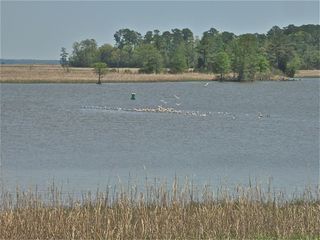
Most of these marshes are found behind some protective barriers that protect their fragile ecosystem from the full forces of ocean waves. (Credit: Linda & Dr. Dick Busher)
Good intentions

Smooth cordgrass, Spartina alterniflora, is the dominant plant that grows within these saltwater marshes. Smooth cordgrass is a perennial grass and is native to the Gulf and Atlantic Coast of North America. In the 1970s it was introduced to the salt marshes along the West Coast of North America to help control erosion, but has now become a major invasive plant problem to the native plants of the West Coast marshes. (Credit: NPS)
Growing to new heights
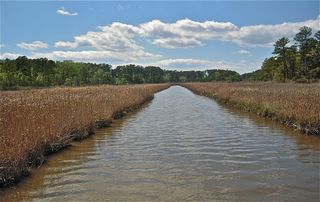
The hollow stems of smooth cordgrass can grow to between 2 to 4 feet (0.6 to 1.2 meters) tall. Leaves tend to be purplish at the base and will be 8 to 20 inches long (20 to 51 centimeters) and 1 to 8 inches (2.5 to 20 cm) wide. Under proper conditions, a mass of smooth cordgrasses growing together can grow up to 7 feet (2.1 m) tall. (Credit: Linda & Dr. Dick Busher)
Spreading and connecting
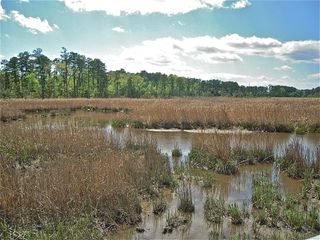
Smooth cordgrass spreads across the tidal marshes by hollow rhizomes. These rhizomes are critical in stabilizing the soft mud of the marsh. Each plant typically spreads laterally up to 2 feet (0.6 m) each year. The rhizomes, roots and shoots of the cordgrass provide life sustaining food and shelter for wetland waterfowl and mammals. (Credit: Linda & Dr. Dick Busher)
The tidal landscapes

Meandering tidal creeks run through these tidal salt marshes. Many small ponds, known as panes, are found between the tidal creeks. Historically, these ponds have been a major breeding ground for salt marsh mosquitoes. (Credit: Linda & Dr. Dick Busher)
From the ground
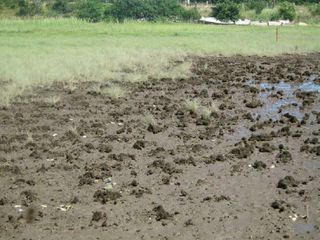
The soil found within these marshes is usually black in color and lacks the normal concentration of oxygen. It is soft due to the saturation of water. A sulfide smell is common when the soil is disturbed. The soil is mostly nonorganic and thus seldom forms peat bogs. (Credit: NPS)
Sign up for the Live Science daily newsletter now
Get the world’s most fascinating discoveries delivered straight to your inbox.
Diversity abounds
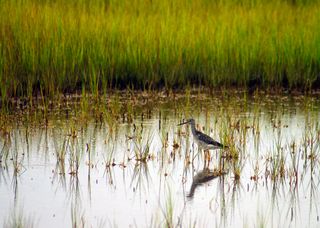
Wildlife is abundant in these North American salt marshes. Greenhead flies, Tabanus nigrovittatus and mosquitoes can be overwhelming. Mussels, crabs, snails and amphibians are common. Small fish are abundant which draws many wading birds, like the Greater yellowleg, Tringa melanoleuca, shown here. The marshes are a favorite of the many migratory birds who pass over them on their annual journeys. Canadian geese, Branta canadensis, are commonly found feeding on the leaves of the acres and acres of smooth cordgrass. (Credit: NPS)
Calling this home

Small mammals find the tidal salt marshes an ideal environment. Mink and otter are also common, as are families of raccoons. These animals feed on the grasses, the many invertebrates and the small fishes found in the watery environment. (Credit: US Fish & Wildlife Service)
Making the ecosystem work

Macro and microscopic algae such as diatoms are common in the waters of the tidal salt marshes. At times, the species are very common, covering both the mud bottoms as well as forming a floating mat upon the surface. They all assist with the detritus food chains found within the marsh and provide a continual food source for algae feeders, such as snails. (Credit: Linda & Dr. Dick Busher)
Increasing diversity
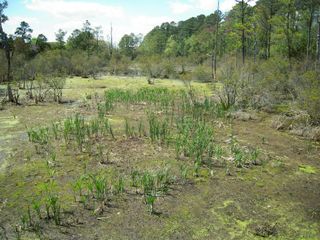
Within some areas of the great North American estuarine saltwater marshes, open woodlands flourish on low-lying islands that arise out of the marshes. Some woodland areas, such as historic Jamestown Island in eastern Virginia, provide a second ecosystem along the Atlantic coastline and enrich the diversity of plant and animal life found within the larger area. (Credit: Linda & Dr. Dick Busher)
Losing history

In an interesting note of history, Jamestown, the original 1607 English settlement in North America, was built in this challenging woodland/estuarine saltwater marsh environment. Since the site of this historic settlement is now only some 3 feet (0.9 m) above sea level, archeologists worry that the whole settlement and island may be covered by water as soon as the year 2050. (Credit: Linda & Dr. Dick Busher)
Restoring balance

The estuarine saltwater marshes of North America are among the most biologically diverse and productive ecosystems on Earth. They provide a key role in filtering out the nutrients from the inflow of both fresh and salt water. Because they are such valuable ecosystems, many local communities near these marshes are involved in constant estuarine monitoring and salt marsh restoration. (Credit: Linda & Dr. Dick Busher)
Originally posted on Live Science.
Most Popular


